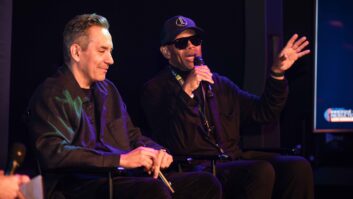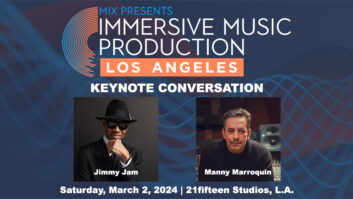
A multi-platinum producer, songwriter and musician, Maine native Rob Graves has racked up millions of record sales and garnered five Dove Awards and nine nominations, plus two Grammy nominations working with artists at the heavier end of the rock spectrum, such as Red, Starset, Halestorm and All That Remains.
Graves, who has also worked with Richard Marx, Benjamin Burnley of Breaking Benjamin and The Civil Wars’ Joy Williams, has written and produced more than 25 number-one songs across all Billboard formats. Combined, songs that he’s written or produced have spent 260 weeks in the active rock top-40, including two number-one songs, several top five hits and multiple number-one rock albums.
Long splitting his time between Maine and Nashville while also working frequently in Los Angeles, Graves for a time had a room, dubbed The Graveyard, at Fred Paragano’s Paragon Studios in Tennessee. While there, Graves signed Red to a production deal in the early aughts, secured a deal with Sony and has just completed their seventh—and reportedly heaviest—album, his sixth with them as producer, writer and engineer. Declaration is independently released on April 10.
Music, Etc.: Robert Tepper — Outlasting The Rest
Music, Etc.: Ranky Tanky — Gullah, Good Time and a Grammy Win
Music, Etc.: Gloria Gaynor — Surviving, Thriving and Testifying
On February 28, Graves released Solstice, a collection of solo improvised piano pieces, initially uploaded to YouTube on a regular schedule as a creative exercise. The album, recorded at his studio in Maine, comprises 16 tracks, including three orchestral arrangements, and is accompanied by Graves’ atmospheric photos of the Icelandic landscape.
On the Plan Behind Solstice:
I didn’t have a strong plan going into it; I just wanted to write these things every week. It was an exploration of my own creativity. I’ve been a songwriter for a long time and I’ve always tried to not understand the process too much. You just like to let it happen; you don’t want to mess with it because you might mess it up.
We spend so much time thinking and planning and outlining things. There’s something about pushing that aside and just sitting down and doing it—and it always comes, if you sit down and do it.
I decided to dive into it a bit more and push myself to show up and say, I’m going to write and release a song today. And watching the creativity respond to that.
I just thought it was a fun side thing to do for people who like my piano and string stuff that I do in the rock projects I produce. People responded really well, and I got requests to release it as a record. It was very organic.
On the Inspiration Behind Solstice:
After I wrote the first song, I thought, I need a backdrop for the screen—I’ll use the landscape photos I took in Iceland. Every song had a different photo, so I included a digital booklet with the album.
I love nature in general, but Iceland feels like the Earth just after it was made, completely raw and primal. Not to be too pretentious, but I wanted these songs to be in that rough state, not polished and as close as they were to when I wrote and improvised them.
On Graves’ Studio Setup:
I have a studio at my house in southern Maine and one up in the mountains in Carrabassett Valley, a big ski resort. Bands can come up and stay.
I work a lot in the box, in Pro Tools HD. I just got the new Mac Pro. I’m gradually migrating over. I use nice preamps; I have an Avalon. When I do my rock stuff, for guitars, I pretty much do everything with Kemper. I have my go-to presets. [Engineer] Mike Plotnikoff does all my drums. We go to L.A., to Howard Benson’s [West Valley Recording] or NRG.
On the Joy of Limitations:
Once I had a studio and a pretty good setup, my former limitations, like trying to get studio time, went away. You notice a bit of listlessness. You’re not sure what to work on. You have to think about it a lot more. Those limitations were kind of good.
Solstice was a bit about that: I’m doing this and I’m releasing it today. It’s a form of combatting having access to 1,000 tracks. I wanted to impose some limitations.
On Working with Red:
I’ve known Fred [Paragano] forever; we went to Berklee together. Fred was a big part of my moving to Nashville originally. I had a place in his studio, and he had this intern, Jasen Rauch, who said, ‘Do you want to hear my band’s demo?’ It was Red. Jasen’s now the guitar player in Breaking Benjamin.
I spent two years making their demo and developed this whole new sound, very cinematic rock. I didn’t set out to do that; the music just started coming—this needs strings!
I spent two years making the first record, about a year making the second record and six weeks doing the current record. They had an opportunity where they needed the record done. Six weeks, are you kidding me? But the songs just arrived; everything worked. For all of us, it’s our favorite record that we’re ever done.
I think the creativity work I did with Solstice really primed me for the Red record.
On Red’s Creative Process:
There’s one main writer in Red, guitar player Anthony Armstrong, and we work with a couple other writers. Anthony and I go to my studio for three or four weeks. I tend to write the lyrics and the topline melodies. Once we get into the flow, I go hiking for the day with my laptop and headphones and find a place to setup and write. Anthony has his task list. I show him my ideas, he shows me the stuff he did, we make a new list and do it all again the next day.
On Coronavirus:
It’s almost like a once-in-a-century opportunity. It’s such a global shakeup that maybe we’ll recognize some systems that weren’t working very well and some things that needed to be fixed and come out of it a lot stronger, moving somewhere better as a culture. I hope we don’t lose this opportunity to grow.







